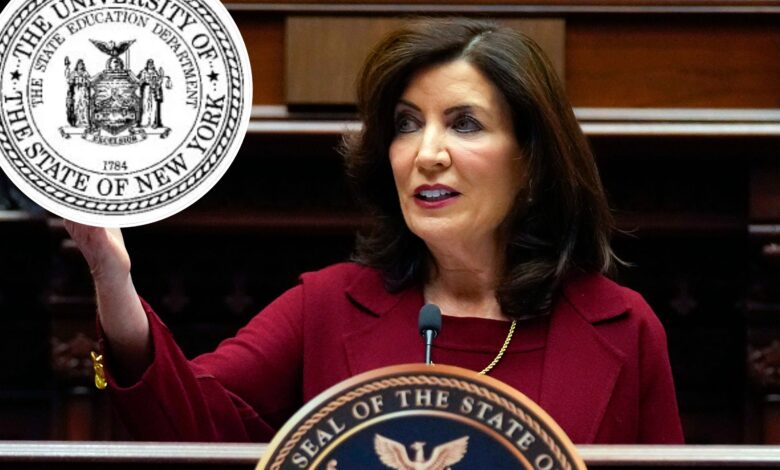Why Hochul’s 10 percent plan for SUNY makes sense

As part of her 2024 State of the State address on Jan. 9, Gov. Hochul announced a plan to offer the top 10% of New York high-school seniors direct admission to the State University of New York (SUNY) system.
“Access to higher education,” Hochul said, “has the potential to transform the lives of young New Yorkers and change the trajectory of a student’s life.”
Hochul’s announcement comes on the heels of Students for Fair Admissions v. President and Fellows of Harvard College, a 2023 US Supreme Court decision that struck down the use of race-based preferences for blacks, Hispanics, and other “underrepresented” minorities in college admissions.
Hochul’s announcement was met with skepticism from some advocates of colorblindness, who suspect the governor’s Top 10 Percent Plan is a backdoor effort to continue the decades of Affirmative Action that penalized whites and Asian Americans in the Empire State.
These skeptics point to the demographics of high schools that are considered “feeders” to the top-ranked SUNY campuses, Binghamton University and Stony Brook University.
Feeder schools tend to have student bodies that are predominantly white and Asian, while non-feeder schools are predominantly black and Hispanic.
Under Hochul’s Top 10 Percent Plan, there is a chance that fewer students from predominantly white and Asian schools will gain admission to Binghamton and Stony Brook; meanwhile, more students from predominantly black and Hispanic schools could be admitted than in years past.
But that does not mean advocates of colorblindness should reject Hochul’s plan outright — at least not in the short run.
The state of Texas’s experience with a percentage plan for college admissions, the plan after which Hochul’s new policy is modeled, helps to illustrate why.
In 1997, the Texas legislature became the first in the nation to pass a percentage plan for college admissions.
The plan, House Bill 588, was signed into law by then-Gov. George W. Bush and guarantees the top 10% of Texas high school seniors automatic admission to any four-year public college or university in the state.
Texas’s Top 10 Percent Plan was passed shortly after the state invalidated the use of affirmative action in its public colleges and universities in 1996.
In the following years, acceptance rates for underrepresented minorities declined at two of the state’s most selective schools – the University of Texas at Austin (UT) and Texas A&M University in College Station (TAMU).
In the years since the Texas legislature passed its Top 10 Percent Plan, UT and TAMU have been unable to recover that lost racial and ethnic diversity.
But the percentage plan has been able to “increase access” in other, race-neutral ways.
A 2022 analysis by education researchers Daniel Klasik and Kalena Cortes found the plan furthered the likelihood that high schools from non-suburban (aka heavily minority) areas of Texas would send students to UT and TAMU, albeit modestly.
In a similar vein, Texas high schools with no prior pattern of sending students to UT and TAMU were more likely to do so once the Top 10 Percent Plan was implemented.
Both are clear wins.
Moreover, Samuel Alito, one of the Court’s most conservative justices, praised the Texas plan in a dissent in 2016’s Fisher v. The University of Texas at Austin (which was another Supreme Court challenge to Affirmative Action).
Alito noted, for example, that “African-American and Hispanic students admitted under the Top Ten Percent Plan receive higher college grades than the African-American and Hispanic students admitted under the race-conscious program.” Another win.
Ever since the Supreme Court struck down the use of affirmative action in college admissions last term, institutions of higher education have been hard at work devising ways to sidestep the ruling.
Encouraging students to write about their race or ethnicity in application essays appears to be the most popular workaround.
Percentage plans for college admissions are not perfect.
For instance, because these plans only take a student’s class rank into account, they ignore the student’s SAT/ACT scores, which can be predictive of how one will fare in college.
That said, a “Top X Percent Plan” is, in principle, meritocratic.
The same cannot be said for race-based essay prompts and other workarounds.
The fight to reform American higher education clearly remains a work in progress.
But for the time being, advocates of colorblindness would be wise to not let “perfect” be the enemy of “good.”
Renu Mukherjee is a Paulson Policy Analyst at the Manhattan Institute.




